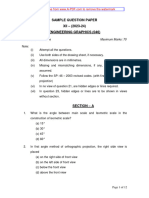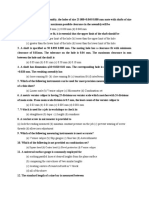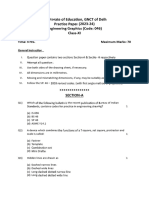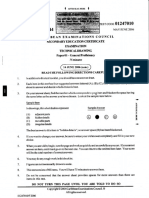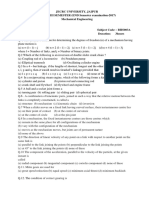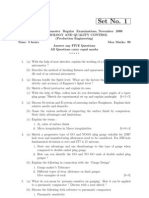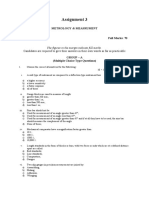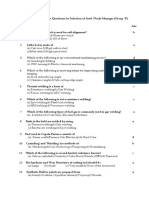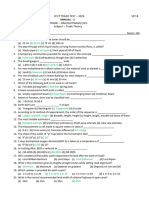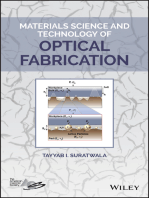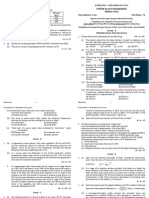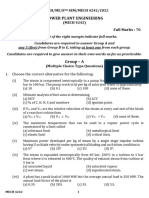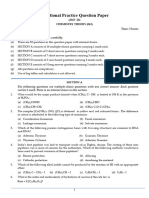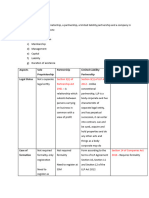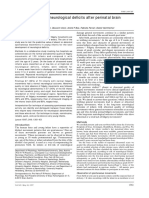Mech 2105
Mech 2105
Uploaded by
kingsukbarman07Original Title
Copyright
Available Formats
Share this document
Did you find this document useful?
Is this content inappropriate?
Report this DocumentCopyright:
Available Formats
Mech 2105
Mech 2105
Uploaded by
kingsukbarman07Copyright:
Available Formats
B.TECH/ME/3RD SEM/MECH 2105/2016 B.
TECH/ME/3RD SEM/MECH 2105/2016
(vii) Involute profile of a gear tooth can be checked by Group - C
(a) Optical Flat (b) Optical Pyrometer
4. (a) Briefly explain with sketch how a Profile Projector works.
(c) Optical profile projector (d) Tooth Span Micrometer.
(b) How a Profile projector can be used for measuring pitch and thread
(viii) LVDT is usually used for measuring
angle of a screw?
(a) temperature (b) pressure
(c) density (d) displacement. (c) Explain with sketch how pneumatic gauges are used for measuring
(i) outside dia of a shaft and (ii) bore taper of a ball bearing inner
(ix) Sine bar should be
race.
(a) used for measurement of an angle greater than 45°
4 + 4 + (2 + 2) = 12
(b) used for measurement of an angle less than 45°
(c) used for measurement of any angle 5. (a) (i) Explain “maximum metal limit” (MML) and “least metal limit”
(d) none of these. (LML) condition for hole shaft assembly with example.
(x) Symbol “inverted triangle” is used in engineering drawings for (ii) What is “Fit”? What are the different types of fit?
representing (b) Calculate the limits of tolerance and allowance for 25 mm shaft and
(a) shape of a component (b) surface Flatness hole pair designated H8d9 type of fit. Size 25 mm falls in the diameter
(c) hardness (d) surface roughness. step 18 and 30 mm. Take i = 0.45√D + 0.001 D microns, IT8=25i,
Group - B IT9=40i. Fundamental deviations for “d” type shaft is (-16 D0.44)
microns.
2. (a) Define the following with suitable sketches: (3 + 3) + 6 = 12
(i) Flatness of a surface
(ii) Roundness Group - D
(iii) Cylindricity. 6. (a) Explain graphically 3 cases when the conditions are:
(b) Explain with sketch how the following can be measured and by using (i) precise but not accurate
which instruments for a lathe (ii) accurate but not precise
(i) The machine is levelled with respect to horizontal plane (iii)accurate and precise
(ii) Radial runout of the headstock spindle (b) (i) What is the difference between followings (any one)
(iii) Parallelism of the headstock spindle with the guide ways. active and passive transducer
(2 × 3) + (2 × 3) = 12 repeatability and reproducibility.
3. (a) Explain with a sketch how tooth thickness at pitch circle diameter is (ii) Write down the calibration method of a vernier caliper.
measured by using a Gear Tooth Calliper (No derivation required). (1 + 1 + 1) + (4 + 5) = 12
Why is this measurement not very accurate?
7. (a) With neat sketch of an actual “surface texture” indicate the
(b) Explain with a sketch what does a tooth span micro meter measures. parameters (i) lay, (ii) waviness, (iii) roughness (vi) sampling length.
Name the design parameters of the gear on which this measured
(b) In the measurement of surface roughness heights of 25 successive
value depends.
peaks and troughs were measured from the centre line and were 32,
(c) A 100mm sine bar is used to measure angle of a component. Slip 26, 37, 35, 42, 22, 35, 18, 42, 28, 35, 22, 37, 18, 42, 22, 32, 21, 37, 18,
gauges having total height of 25.882 mm is put under the sine bar 35, 22, 32, 18 and 34. If the sampling length is 25 mm determine
roller to make the top surface of the component horizontal. Calculate C.L.A. and R.M.S. value.
the angle of the component. (1 + 1 + 1 + 1) + (4 + 4) = 12
(3 + 1) + (3 + 1) + 4 = 12
MECH 2105 2 MECH 2105 3
B.TECH/ME/3RD SEM/MECH 2105/2016
Group - E B.TECH/ME/3RD SEM/MECH 2105/2016
8. (a) A Strain Gauge Load Cell has a single strain gauge mounted on the METROLOGY AND MEASUREMENT
surface of a cylindrical rod along the axis of the rod. The strain gauge (MECH 2105)
is connected to one of the arms of a Wheatstone bridge. The
magnitudes of the resistance of the strain gauge and other Time Allotted : 3 hrs Full Marks : 70
resistances in the other three arms of the bridge are same such that
Figures out of the right margin indicate full marks.
the bridge is balanced (output voltage is zero) when strain in the
strain gauge is zero. Candidates are required to answer Group A and
Given: Input voltage to the Wheatstone Bridge : ei any 5 (five) from Group B to E, taking at least one from each group.
Gauge Factor of the Strain Gauge : F = ∆R / (ϵ.R)
Cross-section area of the rod :A Candidates are required to give answer in their own words as far as
Young’s modulus of the rod material :Y practicable.
Develop the relationship between the axial strain on the rod and the Group – A
voltage developed in the bridge. (Multiple Choice Type Questions)
(b) Develop the relationship between the axial compressive force FC 1. Choose the correct alternative for the following: 10 × 1 = 10
applied on the rod and the voltage developed in the bridge.
(i) The ratio of the infinitesimal change in output to the infinitesimal
9 + 3 = 12 change in input is defined as
(a) sensitivity (b) resolution
9. (a) Explain with neat sketch how a LVDT indicates the magnitude and (c) threshold (d) accuracy.
direction of displacement.
(ii) For measuring comparatively larger internal diameter (for e.g.
(b) Explain the working principal of a bourdon tube gauge with neat 150mm) which instrument is suitable?
sketch. What are the parameters we consider to choose tube (a) Telescopic gauge (b) Inside tubular micrometer
material? Give two examples of tube material. (c) Vernier calliper (d) Vernier height gauge.
5 + (4 + 2 + 1) = 12
(iii) A Pitot tube is used for measuring
(a) diameter of a tube
(b) pressure of fluid flowing through the tube
(c) flow rate of fluid flowing through the tube
(d) density of the fluid flowing through the tube.
(iv) If the Fit between a shaft and hole is designated as N7/m6, assembly
will have
(a) interference fit (b) transition fit
(c) clearance fit (d) cannot be ascertained.
(v) “Waviness” is
(a) primary texture (b) secondary texture
(c) flaws (d) tertiary texture.
(vi) A surface finish of 0.1 micron Ra can be easily achieved by
(a) milling (b) turning (c) grinding (d) shaping.
MECH 2105 4 MECH 2105 1
You might also like
- Time Travelers WifeDocument4 pagesTime Travelers WifeJoyce MadridNo ratings yet
- Ob McqsDocument3 pagesOb McqsPoonam Sachdev100% (1)
- Sails - Js Essentials - Sample ChapterDocument13 pagesSails - Js Essentials - Sample ChapterPackt PublishingNo ratings yet
- EnggGraphics SQPDocument12 pagesEnggGraphics SQPIshwar BankarNo ratings yet
- EnggGraphics SQPDocument12 pagesEnggGraphics SQPNafeesNo ratings yet
- EnggGraphics SQPDocument12 pagesEnggGraphics SQPsinghaayush49658No ratings yet
- 2023 Winter Question Paper (Msbte Study Resources)Document4 pages2023 Winter Question Paper (Msbte Study Resources)Rohan ChavanNo ratings yet
- Csvtu MMMDocument5 pagesCsvtu MMMManish SahuNo ratings yet
- MET Past Paper 1Document9 pagesMET Past Paper 1KYLE TOMLINSONNo ratings yet
- 2019 Winter Question Paper (Msbte Study Resources)Document4 pages2019 Winter Question Paper (Msbte Study Resources)1042 Arun NagariyaNo ratings yet
- Metrology MCQDocument6 pagesMetrology MCQsivakumarNo ratings yet
- 108 2022 Surveyor Grade 2Document14 pages108 2022 Surveyor Grade 2Gayathry SanthoshNo ratings yet
- Official ISRO Previous Paper 2008 - Download Now!Document11 pagesOfficial ISRO Previous Paper 2008 - Download Now!nidhi tripathiNo ratings yet
- Xi - Engineerng GraphicsDocument4 pagesXi - Engineerng Graphicsprecisebusiness23No ratings yet
- MCQ قياسات 22-1Document9 pagesMCQ قياسات 22-1mahmoudelsayad01013No ratings yet
- 11 Engineeringgraphics Eng PP 2023-24-1Document9 pages11 Engineeringgraphics Eng PP 2023-24-1mohitbinjola03No ratings yet
- PDFDocument43 pagesPDFPruthvi KavaiyaNo ratings yet
- Machining E BookDocument37 pagesMachining E BookunitybeginsathomeNo ratings yet
- Q-First Semester Batch Ii Final Examination Theory Question PaperDocument5 pagesQ-First Semester Batch Ii Final Examination Theory Question PaperASHVIN YADAVNo ratings yet
- L-3/T Date: 17/0112016: SectionDocument25 pagesL-3/T Date: 17/0112016: SectionMD. BAKTIAR ALAM KABIRNo ratings yet
- 302 (2023 Dec, Local Que)Document10 pages302 (2023 Dec, Local Que)kyar paukNo ratings yet
- University of Mauritius: September 2015Document7 pagesUniversity of Mauritius: September 2015Keshav GopaulNo ratings yet
- 2017 Winter Question PaperDocument5 pages2017 Winter Question PaperMahesh SelokarNo ratings yet
- 2023 Summer Question Paper (Msbte Study Resources)Document2 pages2023 Summer Question Paper (Msbte Study Resources)Rohan ChavanNo ratings yet
- Emg 3212 Metrology Exam DraftDocument4 pagesEmg 3212 Metrology Exam DraftkiokocurtisNo ratings yet
- Chain Survey ProblemDocument4 pagesChain Survey ProblemRathod SRINIVASNo ratings yet
- Physics MCQs For Entry TestDocument134 pagesPhysics MCQs For Entry TestKamran AliNo ratings yet
- University of Mauritius Faculty of Engineering: (August 2016)Document8 pagesUniversity of Mauritius Faculty of Engineering: (August 2016)Keshav GopaulNo ratings yet
- HT TP: //qpa Pe R.W But .Ac .In: 2011 SurveyingDocument8 pagesHT TP: //qpa Pe R.W But .Ac .In: 2011 SurveyingSaikat DattaNo ratings yet
- 2019 Winter Question Paper (Msbte Study Resources)Document4 pages2019 Winter Question Paper (Msbte Study Resources)Jess DmelloNo ratings yet
- Engineering Drawing Reading Test (GD&T)Document6 pagesEngineering Drawing Reading Test (GD&T)siva dhamotharanNo ratings yet
- RK University: InstructionsDocument3 pagesRK University: InstructionsShiraj SunasaraNo ratings yet
- Manufacturing Processes (Mech 2204)Document3 pagesManufacturing Processes (Mech 2204)kingsukbarman07No ratings yet
- 97.2022 Draftsman Cum Surveyor Mining and GeologyDocument19 pages97.2022 Draftsman Cum Surveyor Mining and GeologyGayathry SanthoshNo ratings yet
- Caribbean Examinations Council Secondary Education Certificate Examination Technical Drawing Paper0l - General ProficiencyDocument12 pagesCaribbean Examinations Council Secondary Education Certificate Examination Technical Drawing Paper0l - General Proficiencyilyas mursalinNo ratings yet
- 146 2023Document18 pages146 2023civillabexperimentsNo ratings yet
- Previous Year Paper Sem 1Document9 pagesPrevious Year Paper Sem 1PROCHES NOLASCONo ratings yet
- Physics: Page 1 of 6Document6 pagesPhysics: Page 1 of 6Asad AbbasNo ratings yet
- 02 - Timber Vocations (Old Questions)Document11 pages02 - Timber Vocations (Old Questions)Min HtetNo ratings yet
- EMG 1205 Manufactruing Processes II - Exam 2022-23Document3 pagesEMG 1205 Manufactruing Processes II - Exam 2022-23kiokocurtisNo ratings yet
- Jecrc University, Jaipur B.TECH III SEMESTER (END Semester Examination-2017) Mechanical EngineeringDocument9 pagesJecrc University, Jaipur B.TECH III SEMESTER (END Semester Examination-2017) Mechanical Engineeringडॉ. कनिष्क शर्माNo ratings yet
- Basic Surveying Winter 2019 Question Paper 1Document4 pagesBasic Surveying Winter 2019 Question Paper 1Bajirao JetithorNo ratings yet
- Summer 2017 Question PaperDocument6 pagesSummer 2017 Question PaperAadil AnsariNo ratings yet
- GTU DOM Paper 2Document2 pagesGTU DOM Paper 2ManavNo ratings yet
- CBSE Class 12 Engineering Graphic Marking Scheme Question Paper 2019-20Document7 pagesCBSE Class 12 Engineering Graphic Marking Scheme Question Paper 2019-20ManikyaMayankNo ratings yet
- (A) Only One Feature at A Time (B) Only Important Dimensions at A Time (C) All The Dimension at A Time (D) Only The Related Dimensions at A TimeDocument23 pages(A) Only One Feature at A Time (B) Only Important Dimensions at A Time (C) All The Dimension at A Time (D) Only The Related Dimensions at A TimePURUSHOTTAMNo ratings yet
- Gujarat Technological UniversityDocument2 pagesGujarat Technological Universityfeyayel990No ratings yet
- rr312002 Metrology and Quality ControlDocument8 pagesrr312002 Metrology and Quality ControlSRINIVASA RAO GANTANo ratings yet
- 1st Year 1st Term, 2015Document12 pages1st Year 1st Term, 2015kobirskr001No ratings yet
- 112 2018 ADocument14 pages112 2018 ATrade CloudNo ratings yet
- Assignment 3 ME 504 MetrologyDocument3 pagesAssignment 3 ME 504 MetrologyArnab BhattacharyaNo ratings yet
- Provisional Answer Key-TechnicalDocument47 pagesProvisional Answer Key-Technicalharnishtanna212No ratings yet
- Sample MCQs For AWM SelectionDocument24 pagesSample MCQs For AWM Selectionnarayananx5No ratings yet
- Winter22 CGRDocument2 pagesWinter22 CGRDerren TuscanoNo ratings yet
- Geometry Practice Sheet SSCDocument2 pagesGeometry Practice Sheet SSCniladri.civil.iitkgpNo ratings yet
- EL-1002 (3)Document4 pagesEL-1002 (3)mk0616446No ratings yet
- Be Summer 2022Document2 pagesBe Summer 2022blastix2104No ratings yet
- DMC Annual 2 Set BDocument3 pagesDMC Annual 2 Set BEr Vicky DuttaNo ratings yet
- 13.production Technology-101-106Document6 pages13.production Technology-101-106Engnr.Muhammad TayyabNo ratings yet
- Question Paper Winter 2019Document2 pagesQuestion Paper Winter 2019MohammadMoizNo ratings yet
- Materials Science and Technology of Optical FabricationFrom EverandMaterials Science and Technology of Optical FabricationNo ratings yet
- Power Plant Engineering 2019Document2 pagesPower Plant Engineering 2019kingsukbarman07No ratings yet
- Power Plant Engineering 2017Document2 pagesPower Plant Engineering 2017kingsukbarman07No ratings yet
- Power Plant Engineering 2018Document3 pagesPower Plant Engineering 2018kingsukbarman07No ratings yet
- Power Plant Engineeringmech 4242 - 2022Document6 pagesPower Plant Engineeringmech 4242 - 2022kingsukbarman07No ratings yet
- Power Plant Engineering-Mech 4242-2023Document4 pagesPower Plant Engineering-Mech 4242-2023kingsukbarman07No ratings yet
- Persons DigestDocument6 pagesPersons DigestMary Ann AmbitaNo ratings yet
- Synopsis PresentationDocument13 pagesSynopsis PresentationSivaNandan AjithNo ratings yet
- Adverse PossessionDocument1 pageAdverse PossessionLuke Lettee BubbNo ratings yet
- Ten Commitments of The Philippines Logistics Services SectorDocument23 pagesTen Commitments of The Philippines Logistics Services SectorPortCallsNo ratings yet
- Evaluation - Steps and Procedures in CounselingDocument2 pagesEvaluation - Steps and Procedures in CounselingJohn DilaoNo ratings yet
- Proposal Skripsi Sastra InggrisDocument16 pagesProposal Skripsi Sastra InggrisAlfitra ainun NissaNo ratings yet
- Feminist Sociology and Feminist Knowledges Contributions To Higher Education Pedagogies and Professional Practices in The Knowledge EconomyDocument26 pagesFeminist Sociology and Feminist Knowledges Contributions To Higher Education Pedagogies and Professional Practices in The Knowledge EconomyVette Angelikka Dela CruzNo ratings yet
- Tareq Haider: Education SkillsDocument1 pageTareq Haider: Education SkillsAbdullah Al RashidNo ratings yet
- Quiz - All My SonsDocument7 pagesQuiz - All My Sonsmari100% (1)
- KD 5 Procedure Text Lat SoalDocument10 pagesKD 5 Procedure Text Lat SoalTri MauludinNo ratings yet
- Operator Guide - Slide Mate Laser - A86110100 - EnglishDocument78 pagesOperator Guide - Slide Mate Laser - A86110100 - EnglishEdgar OrtizNo ratings yet
- Protect PRODUCTS From NATURE So That, PRODUCT Protects You From NATUREDocument14 pagesProtect PRODUCTS From NATURE So That, PRODUCT Protects You From NATUREannayya.chandrashekar Civil EngineerNo ratings yet
- LG 55LM6700 CNET Review Calibration ResultsDocument7 pagesLG 55LM6700 CNET Review Calibration ResultsDavid KatzmaierNo ratings yet
- (Balochistan) : Composite Schedule of RatesDocument229 pages(Balochistan) : Composite Schedule of RatesJawad MaqsoodNo ratings yet
- Ho Ching Ella - Public Resume 2Document1 pageHo Ching Ella - Public Resume 2api-510664967No ratings yet
- Worksheet 75 Adjective Adverb PhrasesDocument2 pagesWorksheet 75 Adjective Adverb PhrasesRochelle Alava Cercado50% (2)
- Vaginal Delivery: Chapter 27 of Williams Obstetrics 24th EditionDocument29 pagesVaginal Delivery: Chapter 27 of Williams Obstetrics 24th EditionsaryindrianyNo ratings yet
- Chemistry PQ2Document10 pagesChemistry PQ2Balvir KaurNo ratings yet
- ENERGETICS EbookDocument96 pagesENERGETICS Ebooklianchen251110No ratings yet
- Mansci 01: Risks and Returns: The Smaller The Standard Deviation, The Tighter The ProbabilityDocument2 pagesMansci 01: Risks and Returns: The Smaller The Standard Deviation, The Tighter The ProbabilityMichelle ManglapusNo ratings yet
- GeophysicsDocument392 pagesGeophysicsNAGENDR_006100% (2)
- Allied Ii Basic Physics - IDocument1 pageAllied Ii Basic Physics - Ivickyani1986yahoo.co.inNo ratings yet
- TutorialsDocument16 pagesTutorialsBee ChunweiNo ratings yet
- TASKS - @krisnadhitaaDocument2 pagesTASKS - @krisnadhitaamuhammad dimasNo ratings yet
- Ecclesiology BibliographyDocument6 pagesEcclesiology BibliographyVictor SundaramNo ratings yet
- Precht L 1997Document3 pagesPrecht L 1997Javiera Rodriguez QuezadaNo ratings yet
- Art and AppriciationDocument10 pagesArt and Appriciationmilky abegail perezNo ratings yet




